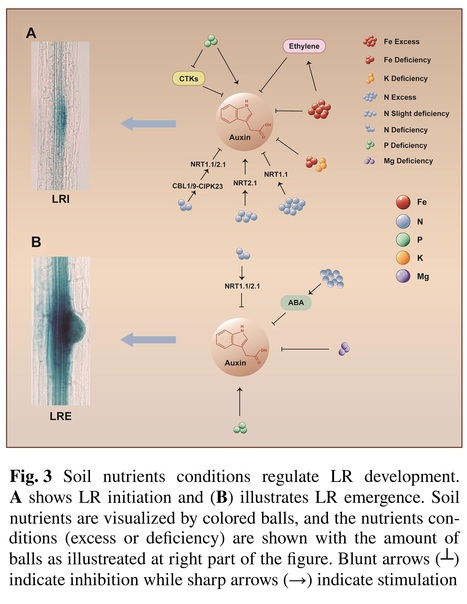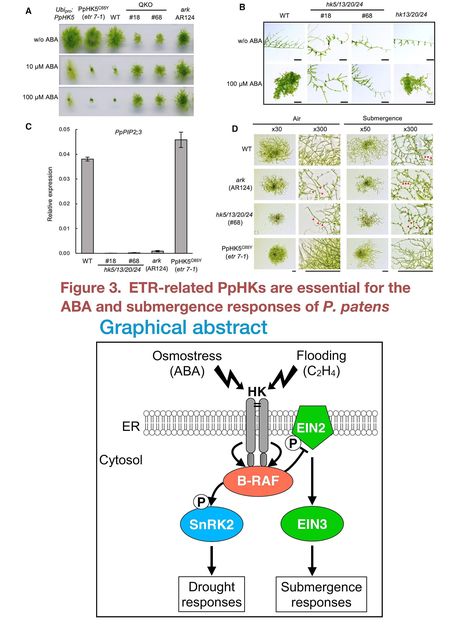 Your new post is loading...
 Your new post is loading...
Authors: Minmin He, Gui Geng, Shuyang Mei, Gang Wang, Lihua Yu, Yao Xu and Yuguang Wang.
Functional Plant Biology (2024)
Abstract: "Water stress (drought and waterlogging) leads to an imbalance in plant water distribution, disrupts cell homeostasis, and severely inhibits plant growth. Melatonin is a growth hormone that plants synthesise and has been shown to resist adversity in many plants. This review discusses the biosynthesis and metabolism of melatonin, as well as the changes in plant morphology and physiological mechanisms caused by the molecular defence process. Melatonin induces the expression of related genes in the process of plant photosynthesis under stress and protects the structural integrity of chloroplasts. Exogenous melatonin can maintain the dynamic balance of root ion exchange under waterlogging stress. Melatonin can repair mitochondria and alleviate damage caused by reactive oxygen species and reactive nitrogen species; and has a wide range of uses in the regulation of stress-specific genes and the activation of antioxidant enzyme genes. Melatonin improves the stability of membrane lipids in plant cells and maintains osmotic balance by regulating water channels. There is crosstalk between melatonin and other hormones, which jointly improve the ability of the root system to absorb water and breathe and promote plant growth. Briefly, as a multifunctional molecule, melatonin improves the tolerance of plants under water stress and promotes plant growth and development."
Authors: Sidra Javed, Xiangzheng Chai, Xiaoming Wang and Shengbao Xu.
Plant and Soil (2023)
Abstract: "Background - Plants rely heavily on the formation of post-embryonic organs, such as leaves, branches, and lateral roots, to adapt to varying soil conditions. Lateral roots (LR) play a crucial role in the plant root system, serving as the primary factor in the exploration of water and nutrients in the soil. The development of LR is meticulously controlled by phytohormones to respond to the information obtained from the surrounding soil. This regulation ensures an optimal arrangement of lateral roots, enabling efficient nutrient absorption and adaptation to the challenging environmental conditions. Scope - This review summarizes recent progress in understanding the mechanisms of lateral root layout in different soil micro-environments and the role of phytohormones in mediating LR development for soil adaptation. Conclusions - The intricate signaling network governing LR layout involves interactions among various soil factors, which are mediated by phytohormones. Despite its complexity, recent studies have yielded significant insights that can be applied to optimize LR arrangement in soil profiles through genetic and cultivation methods to enhance crop yield and stress tolerance."
Authors: Haipei Liu, Amanda J. Able and Jason A. Able.
Trends in Plant Science (2022)
Highlights: Plants have stress memories that lead to epigenetic, transcriptomic, proteomic, and metabolomic changes, enabling enhanced responses to additional stress exposure. Multi-omic studies have identified previously unrecognised regulators, metabolites, and pathways as key components of priming-induced thermotolerance. Successful acclimation for drought and flooding-induced stress memory is linked to changes in antioxidative capacity, biochemical modifications, and hormone pathways. Cross-stress tolerance can be elicited by pre-exposure of a primary stress to improve crop performance under subsequent stress. Application of priming agents is another effective cross-priming approach, particularly for seed priming or commercial seed production. Cross-stress priming success relies on synergistic stress signalling pathways being shared across stresses varying in nature and intensity.
Abstract: "The agricultural sector must produce resilient and climate-smart crops to meet the increasing needs of global food production. Recent advancements in elucidating the mechanistic basis of plant stress memory have provided new opportunities for crop improvement. Stress memory-coordinated changes at the organismal, cellular, and various omics levels prepare plants to be more responsive to reoccurring stress within or across generation(s). The exposure to a primary stress, or stress priming, can also elicit a beneficial impact when encountering a secondary abiotic or biotic stress through the convergence of synergistic signalling pathways, referred to as cross-stress tolerance. ‘Rewired plants’ with stress memory provide a new means to stimulate adaptable stress responses, safeguard crop reproduction, and engineer climate-smart crops for the future."
|
Authors: Petar Mohorović, Batist Geldhof, Kristof Holsteens, Marilien Rinia, Johan Ceusters and Bram Van de Poel.
Plant Direct (2023)
Abstract: "Salinity, drought, and waterlogging are common environmental stresses that negatively impact plant growth, development, and productivity. One of the responses to abiotic stresses is the production of the phytohormone ethylene, which induces different coping mechanisms that help plants resist or tolerate stress. In this study, we investigated if an ethylene pretreatment can aid plants in activating stress-coping responses prior to the onset of salt, drought, and waterlogging stress. Therefore, we measured real-time transpiration and CO2 assimilation rates and the impact on biomass during and after 3 days of abiotic stress. Our results showed that an ethylene pretreatment of 1 ppm for 4 h did not significantly influence the negative effects of waterlogging stress, while plants were more sensitive to salt stress as reflected by enhanced water losses due to a higher transpiration rate. However, when exposed to drought stress, an ethylene pretreatment resulted in reduced transpiration rates, reducing water loss during drought stress. Overall, our findings indicate that pretreating tomato plants with ethylene can potentially regulate their responses during the forthcoming stress period, but optimization of the ethylene pre-treatment duration, timing, and dose is needed. Furthermore, it remains tested if the effect is related to the stress duration and severity and whether an ethylene pretreatment has a net positive or negative effect on plant vigor during stress recovery. Further investigations are needed to elucidate the mode of action of how ethylene priming impacts subsequent stress responses."
Authors: Zhirui Yang, Yibo Cao, Yiting Shi, Feng Qin, Caifu Jiang and Shuhua Yang.
Molecular Plant (2023)
Abstract: "Global climate change exacerbates the effects of environmental stressors, such as drought, flooding, extreme temperatures, salinity and alkalinity, on crop growth and grain yield, threatening the sustainability of the food supply. Maize (Zea mays) is one of the most widely cultivated crops and the most abundant grain crop in production worldwide. However, maize yield stability is highly dependent on environmental conditions. Recently, great progress has been achieved in understanding the molecular mechanisms underlying maize responses to environmental stresses and developing stress-resilient varieties through the rapid advancement of high-throughput sequencing technologies, multi-omics analytic platforms and automated phenotyping facilities. In this review, we summarize recent advances in dissecting the genetic components contributing to maize abiotic stress tolerance through diverse genetic strategies. In addition, we discuss the future challenges and opportunities for developing climate-resilient maize varieties".
Authors: Tsukasa Toriyama, Akihisa Shinozawa, Yuki Yasumura, Masashi Saruhashi, Mayuka Hiraide, Shiori Ito, Hideyuki Matsuura, Keiko Kuwata, Mika Yoshida, Tadashi Baba, Izumi Yotsui, Teruaki Taji, Daisuke Takezawa and Yoichi Sakata.
Current Biology (2022)
Editor's view: Toriyama et al. show that, in the moss Physcomitrium patens, ethylene-receptor- related sensor histidine kinases (HKs) interact with a Raf kinase (RAF) at the endoplasmic reticulum. This HK-RAF module is essential for ethylene-mediated submergence signaling and abscisic-acid-mediated osmostress signaling for optimal environmental stress responses.
Highlights: • Ethylene-receptor-related histidine kinases are essential for moss stress responses • ETR-HKs interact with a RAF kinase at the endoplasmic reticulum • ETR-HKs regulate ABA-dependent activation of SnRK2 via RAF kinase activation
Abstract: "To survive fluctuating water availability on land, terrestrial plants must be able to sense water stresses, such as drought and flooding. The plant hormone abscisic acid (ABA) and plant-specific SNF1-related protein kinase 2 (SnRK2) play key roles in plant osmostress responses. We recently reported that, in the moss Physcomitrium patens, ABA and osmostress-dependent SnRK2 activation requires phosphorylation by an upstream RAF-like kinase (ARK). This RAF/SnRK2 module is an evolutionarily conserved mechanism of osmostress signaling in land plants. Surprisingly, ARK is also an ortholog of Arabidopsis CONSTITUTIVE RESPONSE 1 (CTR1), which negatively regulates the ethylene-mediated submergence response of P. patens, indicating a nexus for cross-talk between the two signaling pathways that regulate responses to water availability. However, the mechanism through which the ARK/SnRK2 module is activated in response to water stress remains to be elucidated. Here, we show that a group of ethylene-receptor-related sensor histidine kinases (ETR-HKs) is essential for ABA and osmostress responses in P. patens. The intracellular kinase domain of an ETR-HK from P. patens physically interacts with ARK at the endoplasmic reticulum in planta. Moreover, HK disruptants lack ABA-dependent autophosphorylation of the critical serine residue in the activation loop of ARK, leading to loss of SnRK2 activation in response to ABA and osmostress. Collectively with the notion that ETR-HKs participate in submergence responses, our present data suggest that the HK/ARK module functions as an integration unit for environmental water availability to elicit optimized water stress responses in the moss P. patens."
|



 Your new post is loading...
Your new post is loading...












